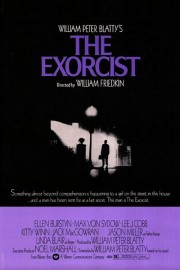The Exorcist
There’s certainly just cause for William Friedkin’s “The Exorcist” to be considered the scariest movie of all-time. Working from a screenplay by comedy writer William Peter Blatty, who also wrote the book the film is based upon, Friedkin adapts the realistic, documentary style of his Best Picture winner, “The French Connection,” to the horror genre in ways that are, sometimes, more jolting than what we see on screen. And when you consider what we see on screen, that’s a tall order.
The film may begin in the desolate deserts of Iraq, with Father Merrin (Max Von Sydow) on a dig where he uncovers artifacts of evil, but it settles in during a sequence in Georgetown, with Chris McNeil (Ellen Burstyn) walking home after a day of shooting a movie. On the surface, the neighborhood she’s walking through seems completely innocuous, but with the Fall wind, the leaves on the sidewalk, and the strains of the piece, “Tubular Bells,” the atmosphere turns an innocent stroll into something more sinuous, and unsettling. Meanwhile, she is hearing strange noises in the attic of the house she’s renting with her daughter, Reagan (Linda Blair), who begins exhibiting strange behavior. The medical signs are all normal, but the behavior continues, and escalates to disturbing acts of violence. That’s when Chris, who has no religious faith, calls on Father Damien Karras (Jason Miller), a priest and psychiatrist who’s been questioning his faith, to try more unorthodox methods. That’s where the title comes in.
One of the best documentaries I’ve ever seen on film is the 25th anniversary documentary about the making, and lasting popularity of, “The Exorcist.” It’s a feature length jewel that goes into every aspect of the film, from the writing of the book to the very release of the film, where it became a lightening rod for controversy (with none other than Billy Graham saying that there was “evil within the celluloid” of the film), and a must-see movie that continues to gain fans now. It’s hard to imagine this film being 40 years old, because it is just as fresh, and immediate, the fifth time as it is the first time.
This is a visceral film, and particular kudos must go not only to the terrific special effects and makeup people behind the scenes, but to Linda Blair’s fearless performance as Reagan McNeil. Of course, it wasn’t all her– there were stunt doubles and prosthetics and the indelible voice of Mercedes McCambridge, who did the demonic voice –but she laid an important foundation of innocence and childlike sweetness that made it all the more shocking when she begins to act, shall we say, rather unorthodox. Her head spins around. She swears like a sailor. She begins to look deathly ill. And, in the most shocking moment, she is found by her mother to be masturbating with a crucifix. I’ll let you guess which one it is that finally, after all conventional medical thought has been exhausted, causes Chris (played by Burstyn in a terrified, emotionally gripping performance) to call on old religious thought, and Father Karras, for help.
What makes the film truly great, however, is the exorcism scenes themselves, when Fathers Karras and Merrin go face-to-face with the demon, and more than that, true evil. It only makes up the last 20 minutes or so of the film, but everything before is leading up to this moment, and Friedkin doesn’t compromise, and back away, from the terror. Yes, it helps that Von Sydow and Miller deliver tremendous performances, but as with Blair’s performance, it’s the combination of writing, directing, special effects, and everything that goes into the filmmaking process that makes that moment where Karras sacrifices his own soul for Reagan land with startling intensity. And the scene where Karras’s friend, Father Dyer (Father William O’Malley), has to give him last rites after he’s fallen to his death down the famous “Exorcist Steps” brings heartbreaking fiinality to the sequence, tempered only slightly by the closing scene with Chris, Reagan, and the Father. The entire film puts the viewer through the emotional ringer, but those last 20 minutes are what turn it into one of the definitive masterpieces of horror cinema.










